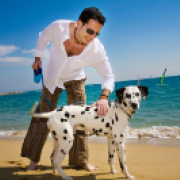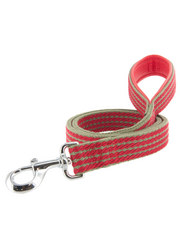
All dogs, regardless of size should be walked regularly. How often depends on the size and temperament of the dog, the level of activity possible in its yard and owner commitments. Walking your dog provides many benefits for your dog. Obviously regular exercise will provide health benefits but it also provides mental and sensory stimulation for your dog. The ability to explore different areas and all the sounds, smells and visual stimuli is a good boredom buster and keeps the dog mentally active. Walks also provide an opportunity for dogs to socialise with other animals and learn appropriate social responses when in the company of other animals. Spending time walking your dog can also enhance the human-animal bond and provide some exercise for the owner.
Scheduling a regular time for taking your dog for a walk can be useful to help ensure it isn't regularly forgotten amongst the myriad of other commitments many owners face daily.
Unless walking your dog in a council designated "off-leash" area, all dogs should be walked on a suitable dog lead attached to a collar or walking harness. Dogs walked in public must always be under the effective control of an owner. Several states have legislation in place about dogs being under the effective control of an adult when in public. Your local council website will be able to provide information on this requirement and list any "off-leash" locations in your area.
Ensuring your dog is adequately restrained with a dog lead will provide control over the dog, keep the dog safe from wandering away and being injured by a motor vehicle and keep the dog from approaching other people and animals.
It is important to note that puppies should not be walked in public places until their puppy vaccination schedule is completed. Your veterinarian will be able to advise on when this will be possible.
Training your dog to respond to basic commends can be of benefit in maintaining control over the dog when walking. Specifically being able to walk the dog without it pulling at the dog lead is a great benefit as is being able to get the dog to sit or heel. Numerous dog obedience schools provide training from the basic levels through to advanced obedience training. Aim to learn how to keep your dog under your effective control whilst on walks. It is generally taught that the dog should walk on the left side of the owner and never have its nose ahead of the owner. Ensure you are walking the dog and that the dog is not walking you!
Some dogs respond well to being walked on dog harnesses. There are several types available. Walking harnesses prevent the dog from being able to pull through its neck and "choke" whilst on walks. They distribute the pulling pressure across the shoulders and sternum rather than across the neck.
Halti collars are very effective in helping train dogs to walk on a dog lead. They go around the muzzle and head and the leash attaches just under the muzzle. The method employed here is that wherever the owner directs the muzzle, the dog will naturally follow in that direction. So every time the dog pulls away, the owner just redirects the muzzle to the direction of walking and the dog will naturally follow. Although the halti collar goes around the dog's muzzle it is not a muzzling device.


Dogs which are suitably trained for walking may be able to walk effectively on a normal dog collar. If a collar is used it is essential to ensure that the collar is not too loose. Dogs can readily slip their collars on walks if an exciting stimulus comes past such as the opportunity to chase a cat, and this could place the dog in danger of a motor vehicle accident. Collars should fit firmly but not be tight.



Choker chains have been used by owners wishing to control their dogs on walks; however the Trixan Pet Staff Vet does not recommend these in most cases as many dogs will pull against the leash, regardless of the fact that the choker chain is restricting their ability to breath. Also choker chains must be put on correctly to ensure that they release the pressure every time the dog stops pulling. Other products such as halti collars can be used as a suitable substitute for these pet leads.
The dog lead chosen should be of suitable thickness and strength for the breed of dog being walked. Short dog leads are useful in helping keep your dog close by your side and under more effective control than longer dog leads where they get free-rein to pull away. Dog leads should be chew-proof and regularly checked that they haven't been weakened by the dog chewing on them. Dog leads should never be left in an area where the dog has free access to it to chew or play with it.
All dogs being taken off their premises should be wearing an identification tag and be microchipped to ensure they can be quickly returned to their owner if they do manage to escape.
It is advised to carry fresh water and a water bowl to hydrate your dog during the walk. Collapsible water bowls are available and are easily transported during your walk. Public taps are also available in most Australian parks.
Owners are often baffled by their dog�s innate ability to deposit faeces as soon as they go on a walk. This is a frustrating experience but needs to be handled responsibly. All faecal matter should be picked up and disposed of appropriately during your walk. Dog "poo bags" or "pooper scoopers" are available in dispensers which attach to your dog's collar or leash so are easily accessible when needed. Many pet suppliers stock these products as well as bag refills. Cleaning up after your dog is part of responsible pet ownership and helps reduce the spread of faecal-borne diseases between animals.
Using your walking as a means of helping socialise your dog is often a very rewarding experience for owners. Ensuring your dog is appropriately socialised at all stages of its life will help reduce barking at other dogs and aggression directed towards other dogs.
Regularly walking your dog provides numerous benefits to both the dog and the owner. All dogs should be walked regularly with daily walks generally recommended, some more active dogs requiring more exercise than this. Ensure your dog is fully vaccinated prior to beginning walks outside your property to reduce the chances of transmission of some viral diseases.